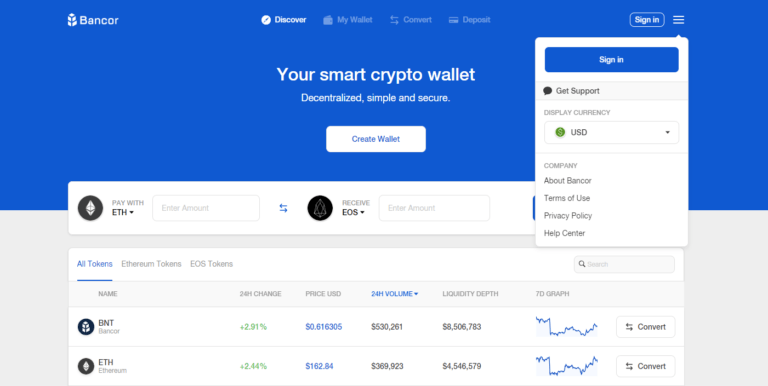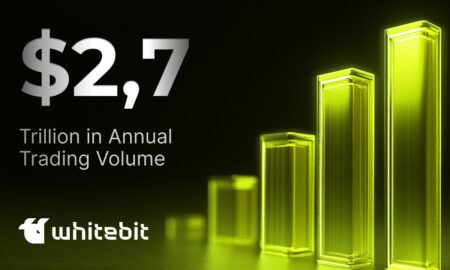Bancor, a Zug, Switzerland-based company focused on developing a protocol for “the creation of smart tokens” which can be traded on a “decentralized exchange service,” has launched a platform that allows for “built-in convertibility” of cryptocurrencies “directly through” smart contracts issued on the network.
Bancor’s Liquid Tokens offer a new form of liquidity that could transform the way we tokenize digital items, ecosystems & more. The key is in the collateral.
Here’s how they work: https://t.co/cbySYv9HLp
Along with brief look back in time (tweet storm coming…) pic.twitter.com/EDTcXEdHoF
— Bancor (@Bancor) April 30, 2019
As noted in a tweet storm, published on April 30th, 2019, from Bancor’s official Twitter account, Bancor’s liquid tokens aim to provide “a new form of liquidity that could transform the way we tokenize digital items” and their supporting ecosystems.
Key To Tokenizing Digital Items Is Collateral
According to Bancor’s developers, the key to tokenizing digital assets is in “the collateral.” Explaining how blockchain-based tokens were introduced, Bancor’s team pointed out that “when Ethereum was born, it promised to allow anyone to launch a token.”
However, the Bancor team believes “this promise quickly faded as many new token creators realized that without liquidity, their tokens were not viable, due to large slippage costs and high volatility.”
“Paying Hefty Listing Fees”
In order to allow users to purchase their cryptocurrency, the “token creators turned to for-profit exchanges, paying hefty listing fees to become liquid,” Bancor’s team wrote. Despite paying a large amount to get their digital asset listed, Bancor’s developers mentioned that “most of these tokens still struggle to gain adoption because the volatility of their token is dependent on the volume of buyers and sellers on an exchange.”
According to Bancor’s management, their company founders “pioneered pool-based liquidity in 2017.” Although this “invention ensures constant liquidity for tokens, offering seamless conversions to users (i.e., low slippage and low volatility) requires funding deep reserve pools — which is often out of reach for new and niche tokens,” Bancor’s team noted.
Bancor Liquid Tokens
To help provide liquidity for new and niche digital assets, Bancor’s liquid tokens allow users to issue tokens that are “liquid from day one.” Bancor’s management claims that newly listed tokens “need no longer suffer from low liquidity and high volatility .”
Going on to explain how their liquidity pools have been developed, the Bancor team mentioned that a “liquid token is a smart contract which acts as an automated market maker.” The contract is able to “regulate the buying and selling of a token along a predetermined price curve, with a single pool of collateral to back it up.”
Elaborating on how this process works, Bancor’s team stated that users are “essentially adding collateral when buying the Liquid Token, and reducing collateral when selling the Liquid Token.”
“Liquid Tokens Continuously Recalculate Price Relative To Their Collateral Token”
According to Bancor’s developers, “Liquid Tokens continuously recalculate their price relative to their collateral token by maintaining a fixed ratio between the Liquid Token’s total value and the value of its reserve pool. This ratio (the ‘reserve ratio’) can be used to maintain a Liquid Token’s price stability.”
The Bancor team further noted that when users trade a Liquid Token, there are three variables which may affect the price that’s quoted:
“1. The amount of tokens in the Liquid Token’s reserve pool,”
“2. The Liquid Token’s reserve ratio,”
“3. The amount of Liquid Tokens being bought or sold”
To illustrate the price curves of Liquid Tokens, Bancor’s team shared the following graphs and tables:
9/ These graphs show the price curves of Liquid Tokens with varying Reserve Ratios (RR). The blue area represents the total market cap of each Liquid Token at its current price, while the red area represents the amount of collateral stored. pic.twitter.com/w9VCEdMNgA
— Bancor (@Bancor) April 30, 2019
10/ This table shows how different Reserve Pool Sizes, Reserve Ratios & Conversion Amounts affect the price of a Liquid Token token, the amount received by the user and the price slippage. pic.twitter.com/Bzo4JStRMB
— Bancor (@Bancor) April 30, 2019
Elaborating on the differences between Liquid Tokens and “Bancor Relays,” the Bancor team noted:
11/ Comparing Bancor Relays v. Liquid Tokens, a Relay is designed for existing tokens & determines prices by balancing 2 token reserves in its smart contract & maintaining a 50% reserve ratio btwn the 2 token reserves.
Learn more about Bancor Relays: https://t.co/acv5MNPYec
— Bancor (@Bancor) April 30, 2019
Commenting further on how a Liquid Token functions, Bancor’s developers mentioned that they’re “a mechanism for creating new, instantly liquid tokens with dynamic supply.” The Bancor team added that “a Liquid Token determines its price by measuring its total value against one reserve (its collateral), and can be configured to maintain any reserve ratio.”
“Liquid Tokens Holding BNT Are Convertible For Tokens On Bancor”
Moreover, “any token can be used as a Liquid Token’s collateral. When Relays/Liquid Tokens hold the same token in one of their reserves, they become convertible for one another,” Bancor’s developers clarified. For instance, Liquid Tokens “holding” BNT, which is Bancor network’s native token, “in their reserve are convertible for tokens on Bancor.”
Bancor’s management continued:
The ability to set any fixed (and in the future, dynamic) reserve ratio for a Liquid Token allows for flexibility in terms of experimenting with various liquidity models … A user may create a Liquid Token that mimics the price stability of a Top-100 traded token, despite it having significantly less volume and a relatively small amount of tokens in its reserve pool.
Alternatively, the Bancor team noted that a user “could imagine a social network where any user or group of users can create their own Liquid Token which rises in value as other users purchase it, and is instantly interchangeable for other tokens in the network and beyond.”
Finally, the Bancor team stated that “a recent wave of liquidity innovations, including Liquid Tokens and Bonding Curves” have allowed for “the world of programmable value [to] unfold before us as tokens move beyond speculation and into everyday consumer applications.”









